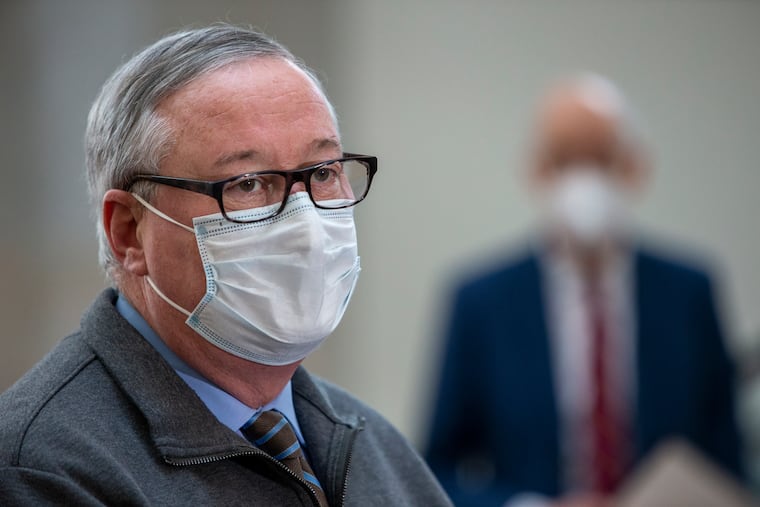Philly is facing a $450 million budget gap and the pain won’t stop there
It could take years for the city to recover from the fiscal impact of the pandemic, and there will soon only be enough money in reserves to run the city for about three days.

Philadelphia officials offered a grim outlook for the city’s finances Tuesday as they warned that the budget Mayor Jim Kenney presents this spring could come with painful cuts to fill a $450 million deficit.
The pain won’t end there: It could take years for the city to recover from the fiscal impact of the coronavirus pandemic, officials said, and there will soon only be enough money in reserves to run the city for about three days.
The warning came as local and state governments across the country are hoping for relief from a new federal coronavirus relief package. Philadelphia officials expressed optimism about the desperately needed lifeline from Washington but said it won’t solve the city’s dire financial situation by itself.
“The devil lies in the details as to whether or not there’s going to be enough direct aid to cities and states,” Kenney said during a news conference. “We’re hoping that the feds will come somewhat to the rescue, but we have to prepare in the interim.”
Kenney’s annual budget proposal has been pushed back from early March to April 15, to allow more time for officials to gauge the potential impact of a federal relief package.
» READ MORE: Kenney had plans. Then the pandemic hit. Can he avoid lame-duck status and get Philly ‘back on track’?
As Kenney braces for his second pandemic-era budget proposal to City Council, he no longer has the reserve and rainy-day funds that were spent to soften the blow of last year’s $750 million budget hole. Even with that cushion, the current budget — reworked after the pandemic hit in March and negotiated during mass protests against systemic racism in June — still included layoffs for 450 employees, hikes in the parking tax and wage tax for nonresident commuters, and spending cuts for several departments.
“Even if we got plenty of stimulus in the coming year, that’s one-time money,” Budget Director Marisa Waxman said. “But we have real structural problems and we need to sort of stretch that out.”
Additional spending cuts or tax increases will be needed to fill the projected budget hole for the fiscal year that starts in June. But officials said they haven’t yet determined specifics.
“It’s early in that process, so we don’t know exactly what those decisions will be, but we know that they would have to be very painful,” Finance Director Rob Dubow said.
» READ MORE: The pandemic took a big bite out of Philly’s tax base. What happens if suburbanites keep working from home?
The city must also develop a spending plan for the next five years, and in doing so will have to grapple with longer-term questions. Those include how many suburban commuters will return to city offices, how changes in tax rates could impact economic recovery, and how to pay for catching up with post-pandemic backlogs in the court system and other areas of government.
Tax revenues are expected to increase as more people are vaccinated and the economy recovers, but Philadelphia officials don’t project a return to pre-pandemic revenue figures in the coming fiscal year, which runs through June 2022. Expenses are also expected to increase, including for items such as insurance and homeless services.
Every option for filling the budget gap has a downside, Waxman said. Tax hikes could stifle the economic recovery, for example, and deferring costs only kicks the can down the road.
“Unfortunately there are no silver bullets in the bunch,” she said.
And City Council is sure to have its own ideas once the mayor presents his spending plan, with the razor-thin margins setting the stage for tense negotiations this spring. One point of contention is likely to be police spending. Some lawmakers, including Council President Darrell L. Clarke, have voiced support for reducing the police budget after protests against police brutality. Kenney has said he’s committed to police reform and a budget that improves racial equity in city government, but he opposes reducing the size of the police force.
By the end of the current fiscal year in June, the city expects to have just $29 million in reserves. That amount would cover less than three days of city expenses, Waxman said. The city ended fiscal year 2019, the last full year before the pandemic hit, with $438 million in reserves — and even that amount was far less than the $800 million recommended under best practices for municipal budgeting.
That small cushion could require budget adjustments between now and June to cover the cost of snowstorms, the pandemic response, and other items. The second quarter of the current fiscal year, which ended Dec. 31, included $10 million more in spending than anticipated due to the presidential election, protests, trash collection, and the pandemic, according to a quarterly financial report released Tuesday.
With expenses adding up, officials warned they won’t be able to reverse cuts made last year, which included closing swimming pools for the summer and cutting funding for the arts.
The city is attempting to include residents in the budget process this year, and will allow the public to submit ideas for spending $1 million in capital investments. A public survey for that effort launched Tuesday.
Still, further cuts are likely on the way.
“Basically at this point as we’re still developing” the budget, Waxman said, “everything is on the table.”
Staff writer Sean Collins Walsh contributed to this report.